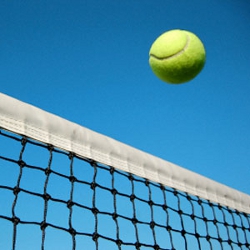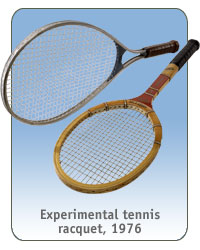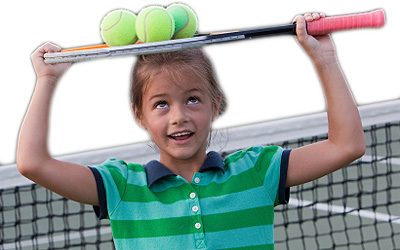Lesson: Tennis, Anyone?
 Lesson adapted from TryEngineering.org.
Lesson adapted from TryEngineering.org.
Summary
In this lesson, teams of students in grades 3 to 12 explore how engineers incorporate the latest materials and manufacturing techniques to improve the performance of sports equipment by constructing a functional racquet out of everyday materials that can volley against another team’s racquet at least six times.
Grade level: 3 – 12
Time: Two to three 45-minute sessions
Learning objectives:
- Learn about engineering design and redesign
- Learn about materials engineering
- Learn how engineering can help solve society’s
challenges - Learn about teamwork and problem solving.
Learning outcomes
After doing this activity, students should have a deeper understanding of:
- materials
- engineering design
- sports engineering
- teamwork
 Standards
Standards
National Science Education Standards Grades [K-4]
- Content Standard A : Science as Inquiry As a result of activities, all students should develop abilities necessary to do scientific inquiry [Grades K-12]
- Content Standard B: Physical Science As a result of the activities, all students should develop an understanding of properties of objects and materials, and position and motion of objects. [Grades k-4] Properties and changes of properties in matter, transfer of energy, motions and forces. [Grades 5 -12]
- Content Standard E: Science and Technology As a result of activities, all students should develop abilities of technological design [Grades K -12], and abilities to distinguish between natural objects and objects made by humans, [Grades K- 8] understanding of science and technology, [Grades 5 – 12]
- Content Standard F: Science in Personal and Social Perspectives As a result of activities, all students should develop understanding of science and technology in local, [Grades K-4] national, and [Grades 5 – 8] global challenges [Grades 9 -12].
- Content Standard G: History and Nature of Science As a result of activities, all students should develop understanding of science as a human endeavor [Grades K-4], the nature and history of science [Grades 5 -12]
Standards for Technological Literacy
The Nature of Technology
- Standard 1: Students will develop an understanding of the characteristics and scope of technology.
- Standard 3: Students will develop an understanding of the relationships among technologies and the connections between technology and other fields of study.
Technology and Society
- Standard 4: Students will develop an understanding of the cultural, social, economic, and political effects of technology.
- Standard 6: Students will develop an understanding of the role of society in the development and use of technology.
- Standard 7: Students will develop an understanding of the influence of technology on history.
Design
- Standard 8: Students will develop an understanding of the attributes of design.
- Standard 9: Students will develop an understanding of engineering design.
- Standard 10: Students will develop an understanding of the role of troubleshooting, research and development, invention and innovation, and experimentation in problem solving.
Abilities for a Technological World
- Standard 11: Students will develop abilities to apply the design process.
The Designed World
- Standard 19: Students will develop an understanding of and be able to select and use manufacturing technologies.
Sheffield University’s Dr. David James introduces sports engineering through its impact on tennis:
[youtube]http://www.youtube.com/watch?v=2xJ3q3q1i4c&list=UUw71MnGL9BQd7gMv7upVvUQ&index=2&feature=plcp[/youtube]
Materials
For the tennis court:
Prepare ahead of time a ping-pong ball covered in hook and loop (Velcro) plus a target board of cloth or Velcro with scoring box.
For each student team:
- Pipe cleaners
- Bendable aluminum wire
- soda straws
- paper towel tubes
- paper clips
- tape
- balloons
- glue
- string
- foil
- plastic wrap
- pens
- pencils
- paper
- other everyday classroom items, as available in classroom
- Student Resource & Worksheets [pages 4 and 5 – 7 of the .pdf]
Procedure
1.Show students the student reference and work sheets. These may be read in class or provided as reading material for the prior night’s homework.
2. To introduce the lesson, consider asking the students how the tennis racquet has evolved over time. Ask them to think about how engineers incorporate newer materials or manufacturing processes to change and improve the performance or durability of a product.
3. If the Internet is available, have students review the resources on the history and manufacturing of tennis racquets on the International Tennis Federation website.
4. Working in teams of 3-4, students should consider their challenge and conduct research into how tennis racquets are manufactured
5. Teams then consider available materials and develop a detailed drawing showing their racquet design – including a list of materials they will need to build it.
6. Students build their racquet and test it under teacher supervision. Each racquet must be able to direct a ping-pong ball that has been covered in hook and loop (Velcro) onto a cloth or board with a target drawn on it. Team scores are based on highest scores on the target.
7. Students should observe the materials used and the design of other teams and gauge their performance.
8. Teams reflect on the challenge, and present their experiences to the class.
Additional Resources
Engineering Sport [4:16] From “toe the line” (the earliest example of sports engineering) to high-tech diving boards and Wii games, this short video from Sheffield Hallam University’s Centre of Sports Engineering Research entertains as well as informs.

Science of the Summer Olympics: Engineering in Sports. Series of 10 videos produced by the National Science Foundation with NBC Learn and NBC Olympics showing top Olympics athletes and engineers discussing how technology provides a performance edge in swimming, wrestling, long jump, and track.
Olympic.org Official website of the Olympic Movement has
International Tennis Hall of Fame. Champions, the history of tennis, museum and more.
The International Tennis Federation‘s introduction to racquets. World tennis’s governing body website includes photos of how tennis balls are manufactured.
Morris Twins on Sports Engineering. [2:51] ESPN video of high-tech training system to build basketball players’ speed and reaction time.
Filed under: Class Activities, Grades 6-8, Grades 9-12, Grades K-5
Tags: Class Activities, Design, Grades 6-8, Grades 9-12, Grades K-5, Olympics, Sports, Sports Engineering, tennis








